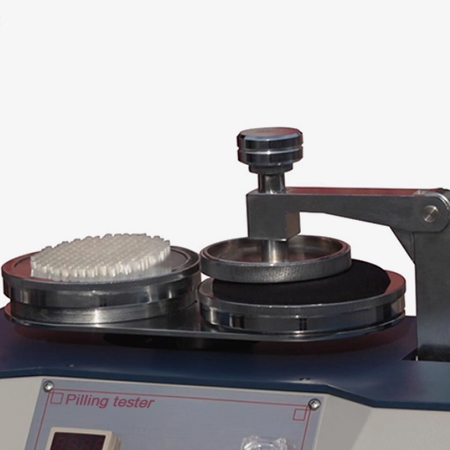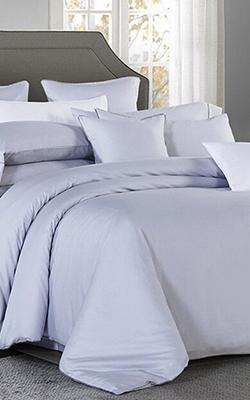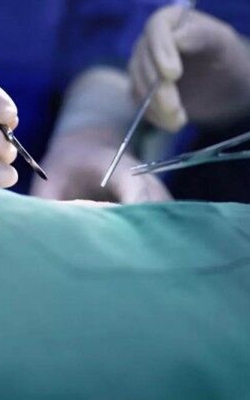The fabric pilling test machine comes with a nylon brush and abrasive disc, which move relative to each other in a circular motion. The controller supports digital settings from 1 to 9999 times, and the motion path is φ40mm ± 1mm. The fabric pilling tester is applied to detect pilling on everyday apparel fabrics, industrial protective fabrics, and automotive seat fabrics.

Adjustable nylon brush height, and the replaceable weight.
- A standard abrasive is fixed to the surface of a circular metal disc, which moves relative to the sample holder. The fuzzy pilling tester's disc is designed to simulate the friction experienced by fabrics in actual use. By rubbing a standard abrasive, such as a specific fabric or sandpaper, against the sample, the fibers are raised and tangled into balls.
- The bristle brush height of the fabric pilling tester is adjustable from 2 to 10 mm. Before the actual friction, the nylon brush rotates at a high speed of 60 rpm to lift the fibers on the sample surface, creating a fuzzy fuzz that creates a suitable pellet.
- The pilling tester machine comes with two weights of different weights: 100 CN and 290 CN, allowing you to choose the right weight based on your experimental requirements. The weights use gravity to provide a constant pressure between the sample and the abrasive (or nylon brush), simulating the forces experienced in actual use.

The counting controller can be set for, wide range of applications
- The pilling tester's counter can be set to a preset number of friction times (1 to 9999), automatically stopping upon reaching the set value to ensure a consistent fabric pilling test.
- The control panel buttons control the start and pause of the fuzzy pilling tester, as well as adjust the speed and friction times.
- The metal housing provides rigid support for the pilling tester machine's specimen table and friction mechanism, maintaining stable and repeatable circular motion.
- The metal housing effectively protects the abrasion and pilling tester's delicate internal components from damage caused by external impact or friction.
Application
The circular locaus pilling tester is a device specifically designed to evaluate the pilling properties of textiles. Fabric pilling testers can be widely used for fabric pilling tests on materials such as clothing, home textiles, automotive interior materials, and medical protective fabrics.

Household Textiles

Automotive Interior Textiles

Medical Protective Fabrics

Clothing
| Model | SISCO-PT-YG502B |
| Type | Circular locus pilling tester |
| Motion Trajectory | φ 40mm ± 1mm circular trajectory |
| Motion Speed | 60r/min ± 1r/min |
| Brush Height | Adjustable from 2mm to 10mm |
| Counting Range | 1 to 9999 |
| Dimension |
600×300×430mm |
| Power Supply | AC220V ± 10, 50Hz, 90W |
| Specimen Specifications | Circular shape with a diameter of 113mm |
| Weight | 35kg |
Q1: What is a pilling tester?
A1: The pilling tester is a specialized test device used to evaluate the degree of surface fuzzing and pilling of textiles (such as woven and knitted fabrics) under friction conditions. It quantifies the fabric's pilling resistance by simulating the friction experienced during daily wear or washing.
Q2: How does a fabric pilling tester work?
A2: The fabric pilling tester applies a specific pressure to the specimen, contacting it with a standard abrasive (such as a nylon brush, sandpaper, or cork backing). The mechanical motion creates friction, leading to fiber breakage, fuzzing, and ultimately, pilling. During the pilling stage, the fiber ends detach from the fabric surface due to friction, forming fuzz. During the pilling stage, the fuzz entangles into balls, some of which fall off due to continued friction.
Q3: What is the function of a pilling tester?
A3: The pilling tester machine simulates the frictional environment fabrics experience during wearing, washing, and daily use by applying friction, pressure, and motion. It also measures the fabric's resistance to pilling by detecting whether fibers on the surface tend to loosen, tangle, and form pills. The test results can guide the apparel, home textile, and other industries in selecting more durable fabrics, enhancing the comfort and lifespan of end products.
Tips: How to use a pilling tester?
Position the pilling tester horizontally, clean the brush, and trim any protruding nylon threads. Cut the specimen according to the standard and secure it in the specimen chuck with the front side facing outward. Select the weight pressure based on the fabric type, tightening the weight onto the chuck shaft to prevent loosening. Then set the counter. Use a nylon brush during the pilling phase, and change to a fabric abrasive during the pilling phase. Flip the chuck bracket, clamp the specimen, and lower it so that it is in full contact with the abrasive surface. After the test, raise the chuck, remove the specimen, and clean any loose fibers from the surface.
Thank you for buying industrial test and measurement equipment on SISCO.com, all products sold by SISCO and the partner cover a 12 months warranty, effective from the date of receiving the products.
What is covered?
SISCO is responsible for providing free spare parts, and free technical support to assist the customer to repair the defective products until the problem is solved.
What is not covered?
- Product purchased from anyone other than a SISCO store or a SISCO authorized reseller.
- Expendable parts.
- Routine cleaning or normal cosmetic and mechanical wear.
- Damage from misuse, abuse or neglect.
- Damage from use of parts other than SISCO approved.
- Damage from use outside the product’s usage or storage parameters.
- Damage from use of parts not sold by SISCO.
- Damage from modification or incorporation into other products.
- Damage from repair or replacement of warranted parts by a service provider other than a SISCO authorized service provider.
- Damage caused by the application environment not meeting the product usage requirements and the failure to perform preventive maintenance.

